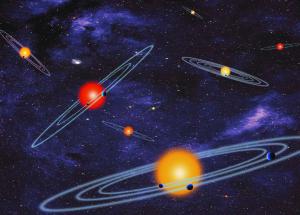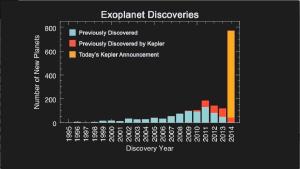Blog
Vast Worlds
26 February 2014
 NASA
NASAThe Kepler mission has announced the addition of 715 new exoplanets to the official list of known worlds. This almost doubles the number of confirmed planets to the list.
It’s hard to understate just how big of a leap this is. If you look at the figure you can see how this latest announcement dwarfs past annual tallies. What’s more, most of these new planets are not large, Jupiter-type worlds. The number of Earth-sized worlds has increased by a factor of 4, and the number of “super-Earths” (up to twice Earth size) has increased by a factor of 6. So most of these new planets are rocky and Earth-like.
 NASA
NASASo how were we able to nearly double the number of planets in a single go? Usually data for an exoplanet has to be examined by hand. This means going through the candidate planet data and determining if there is strong enough evidence to confirm a planet.
But this time a team looked at candidate planets that are part of a possible system of multiple planets. They then applied statistical analysis on the data to pull out the best possible solutions that would be part of a stable system. This poses its own challenges, as I’ve talked about before. But the advantage is that when planetary systems are confirmed they yield multiple planets at once. Looking at planetary systems also helps distinguish signal from noise.
Kepler has finished its primary data gathering period, but there are still more than 2,000 candidate exoplanets that could still be confirmed. Then there are other spacecraft gathering data that will lead to still more exoplanet discoveries. We’re just getting started.